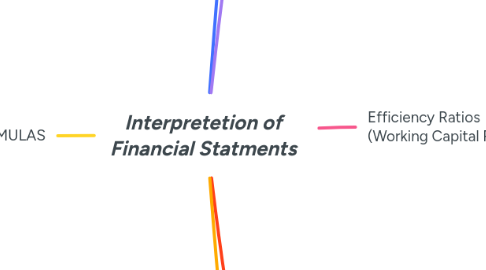
1. ALL FORMULAS
1.1. 1 Gross Profit Ratio = (Gross Profit / Net Sales ) * 100 2 Operating Profit Ratio = (Operating Profit / Net Sales ) * 100 3 Return on Capital Employed = (Operating Profit / Capital Employed ) * 100 4 Capital Employed = Total Assets ( - ) Current Liabilities OR =Equity Capital (+) Reserves and Surplus (+) Pref Capital (+) Debt 5 Net Asset Turnover= Sales Revenue / Capital Employed 6 Working Capital Turnover= Sales Revenue / Working Capital 7 Working Capital = Current Assets ( - ) Current Liabilities 8 Current Ratio = Current Assets / Current Liabilities 9 Quick Ratio = Quick Assets / Current Liabilities 10 Quick Assets = Current Assets ( - ) Inventory 11 Inventory Holding Period = (Inventory / Cost of Sales) * 365 12 Inventory Turnover = Cost of Sales / Inventory 13 Receivables Days = (Trade Receivables / Credit Sales ) * 365 14 Receivables Turnover = (Credit Sales / Trade Receivables) 15 Payable Days = ( Payables / Credit Purchases ) * 365 16 Payables Turnover = (Credit Purchases / Payables ) 17 Debt Equity Ratio = Debt / Equity (Equity Gearing) 18 Debt Equity Ratio = Debt / (Debt + Equity ) (Total Gearing) 19 Interest Cover = PBIT / Interest 20 Cash Cycle = Inventory Holding Period ( + ) Receivable Days ( - ) Payable Days Working Capital Cycle
2. Profitability Ratios
2.1. 1.) Gross Profit Margin / Gross Profit Ratio = [GROSS PROFIT/ NET SALES]*100 Note: Gross profit= net sales- cost of sales Net sales= Total sales- sales return
2.1.1. 2.) Operating Profit Margin = [OPERATING PROFIT/ NET SALES]*100 Note: Operating profit= Profit before interest and tax Operating profit is nothing but the amount you get after deducting admin costs, selling and distribution cost, depreciation from gross profit
2.1.1.1. 3.) Return on Capital Employed= (OPERATING PROFIT/ CAPITAL EMPLOYED) * 100 Operating Profit = Profit before interest and tax Capital Employed = Total Assets - Current Liabilities Equity share capital + Reserves and Surplus + Long term debt + Pref Capital
2.1.1.2. Return on Capital Employed
3. Liquidity Ratios
3.1. 1.) Current Ratio = [CURRENT ASSETS/ CURRENT LIABILITIES] Note: This ratio tells me if my current assets are enough to take care of my current liabilities - In earlier days, 2 : 1 was considered as the ideal current ratio - However, in recent times, a ratio of 1.5:1 is considered ideal.
3.1.1. 2.) Quick Ratio / Liquid Ratio/ Acid Test Ratio = [QUICK ASSETS/ CURRENT LIABILITIES] Note: Quick Assets = Current Assets - Inventory Ideal ratio is 0.7 : 1
4. Efficiency Ratios (Working Capital Related)
4.1. 1.) Inventory Turnover Period / Inventory Holding Period = [ INVENTORY / COGS ] *365/12 Note: This ratio tells how efficiently the company is managing its inventory It tells me, for how long does the company hold its inventory from the date of purchase to the date of sale Higher the ratio, the worse it is. Higher days of holding means I need a longer time to sell the goods after they are purchased Sometimes, businesses deliberately over stock their warehouse because they might think that goods will be scarce in the future.
4.1.1. 2.) Receivables Collection Period = [TRADE RECEIVABLES/ CREDIT SALES] * 365/12 Note: This ratio tells me how much time, on an average, is needed to collect money from debtors If opening and closing debtors are given, better to use 'Average Debtors'. Average Debtors = (Opening Debtors + Closing Debtors) / 2 ** Trade Receivables is another word for 'Debtors'
4.1.1.1. 3.) Payables Payment Period= [TRADE PAYABLES/ CREDIT PURCHASE] *365/12 Note: If credit purchases are not given, please use total purchases If Purchase itself is not given, use cost of sales This ratio tells me, on an average, within how much time are the creditors paid off
4.1.1.1.1. 4.) Cash Cycle OR Operating Cycle= Inventory Holding period + Receivables Collection Period - Payables Payment Period Note: Lower the better
4.1.1.2. Payables Turnover = (Credit Purchases / Trade Payables)
4.1.2. Receivables Turnover = (Credit Sales / Trade Receivables) ** This is expressed in times Receivables collection period and Receivables Turnover are reciprocals
4.2. Inventory Turnover = (Cost of Sales / Inventory ) ** This is expressed in times - Higher the ratio, better it is - Inventory Holding Period and Inventory Turnover are reciprocals of each other
5. Turnover Ratios
5.1. 1.)Net Asset Turnover Ratio = [SALES REVENUE/ CAPITAL EMPLOYED] Note: This is expressed in times, not in percentage.
5.1.1. 2.) Working Capital Turnover = [SALES REVENUE / WORKING CAPITAL] Note: This is expressed in times, not in percentage Working Capital = Current Assets - Current Liabilities
6. Gearing Ratios
6.1. 1.) [A] Formula I (Equity Gearing - Alternate name)= [Debt / Equity] ---------------------------- This tells me debt is what % of equity. Debt = Long term borrowings ** If Preference Capital is given, then unless stated otherwise, please include it under debt Irredeemable Pref shares should be included in Equity
6.1.1. 1.) [B] Formula II (Total Gearing)= [Debt / (Debt + Equity)] -------------------------- This tells me debt is what % of total capital employed What should you do in the exam? - If it is Redeemable Preference Shares, club it under debt (Redeemable means those which will be repaid) - If it is Irredeemable Preference Shares, club it under equity (Irredeemable means those which will not be required to be repaid)
6.1.1.1. 2.) Interest Cover = [PBIT / Interest] Note: Indicates ability of the company to pay the interest It answers the question, is your PBIT enough to pay your interest liability
